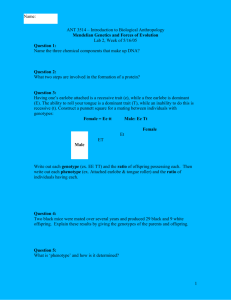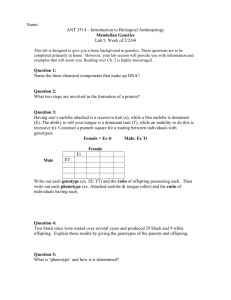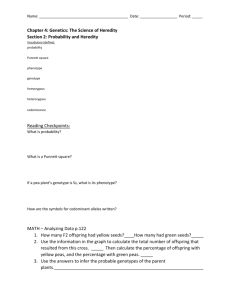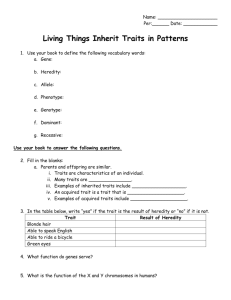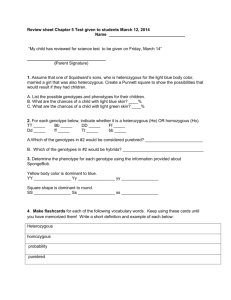phenotype - El Camino College
advertisement
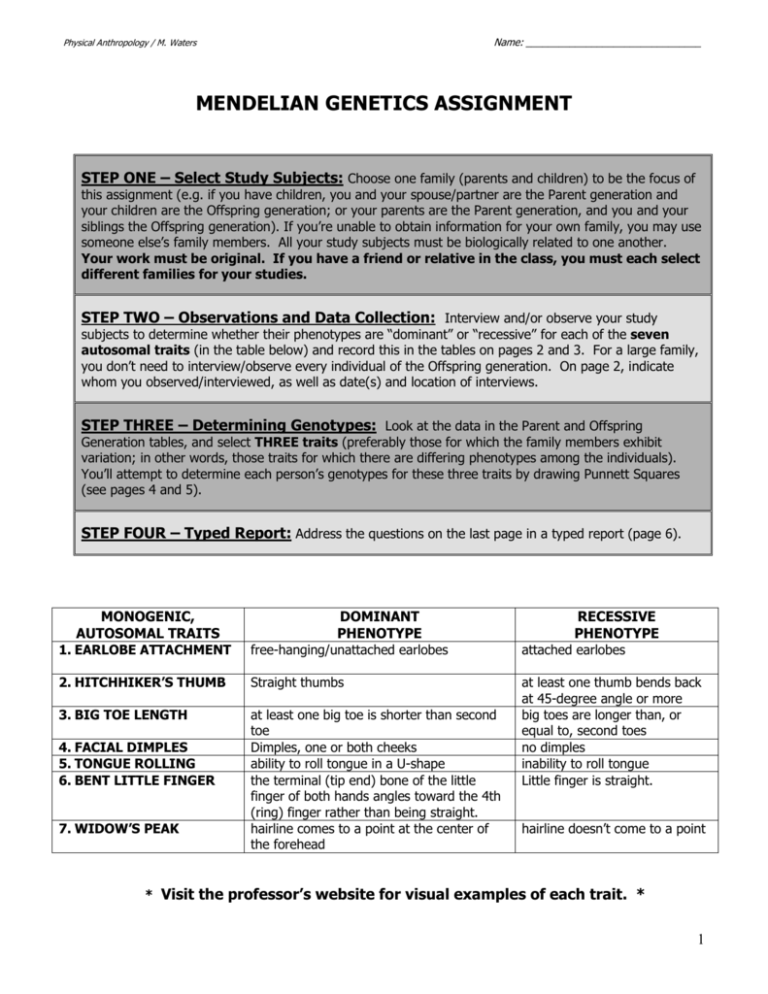
Name: ________________________________ Physical Anthropology / M. Waters MENDELIAN GENETICS ASSIGNMENT STEP ONE – Select Study Subjects: Choose one family (parents and children) to be the focus of this assignment (e.g. if you have children, you and your spouse/partner are the Parent generation and your children are the Offspring generation; or your parents are the Parent generation, and you and your siblings the Offspring generation). If you’re unable to obtain information for your own family, you may use someone else’s family members. All your study subjects must be biologically related to one another. Your work must be original. If you have a friend or relative in the class, you must each select different families for your studies. STEP TWO – Observations and Data Collection: Interview and/or observe your study subjects to determine whether their phenotypes are “dominant” or “recessive” for each of the seven autosomal traits (in the table below) and record this in the tables on pages 2 and 3. For a large family, you don’t need to interview/observe every individual of the Offspring generation. On page 2, indicate whom you observed/interviewed, as well as date(s) and location of interviews. STEP THREE – Determining Genotypes: Look at the data in the Parent and Offspring Generation tables, and select THREE traits (preferably those for which the family members exhibit variation; in other words, those traits for which there are differing phenotypes among the individuals). You’ll attempt to determine each person’s genotypes for these three traits by drawing Punnett Squares (see pages 4 and 5). STEP FOUR – Typed Report: Address the questions on the last page in a typed report (page 6). MONOGENIC, AUTOSOMAL TRAITS 1. EARLOBE ATTACHMENT DOMINANT PHENOTYPE free-hanging/unattached earlobes RECESSIVE PHENOTYPE attached earlobes 2. HITCHHIKER’S THUMB Straight thumbs 3. BIG TOE LENGTH at least one big toe is shorter than second toe Dimples, one or both cheeks ability to roll tongue in a U-shape the terminal (tip end) bone of the little finger of both hands angles toward the 4th (ring) finger rather than being straight. hairline comes to a point at the center of the forehead at least one thumb bends back at 45-degree angle or more big toes are longer than, or equal to, second toes no dimples inability to roll tongue Little finger is straight. 4. FACIAL DIMPLES 5. TONGUE ROLLING 6. BENT LITTLE FINGER 7. WIDOW’S PEAK hairline doesn’t come to a point * Visit the professor’s website for visual examples of each trait. * 1 OBSERVATIONS AND RECORDING YOUR DATA Whom did you interview/observe?___________________________________________ Date(s) and location(s): ___________________________________________________ Parent Generation Phenotypes Fill in the names of the parents in the blank spaces of the top row of the table (e.g. “Mom”, “John”). Observe, or interview, each person to determine his/her phenotype for each of the seven monogenic, autosomal traits (visual examples available on the professor’s website). Indicate this by writing dominant or recessive for each one. TRAITS PHENOTYPE PHENOTYPE Earlobe Attachment Hitchhiker’s Thumb Big Toe Length Facial Dimples Tongue Rolling Bent Little Finger Widow’s Peak 2 Offspring Generation Phenotypes Fill in the names of the offspring in the blank spaces in the top row (create another table on a separate sheet of paper if there are more than five children in the family). Observe, or interview, each person to determine his/her phenotype for each of the seven monogenic, autosomal traits (visual examples available on the professor’s website). Indicate this by writing dominant or recessive for each one. TRAITS PHENOTYPE PHENOTYPE PHENOTYPE PHENOTYPE PHENOTYPE Earlobe Attachment Hitchhiker’s Thumb Big Toe Length Facial Dimples Tongue Rolling Bent Little Finger Widow’s Peak 3 DETERMINING GENOTYPES USING PUNNETT SQUARES READ ALL OF THE FOLLOWING DIRECTIONS CAREFULLY BEFORE BEGINNING THIS PORTION OF THE ASSIGNMENT: 1. From the Parent and Offspring tables on pages 2 and 3, choose THREE traits (ideally those that differ amongst the family members). Your goal is to try to determine the GENOTYPES for each family member for each of these three traits. 2. Refer to the phenotypes in the Parent and Offspring tables for the three traits you selected. On a sheet of scratch paper (that you must hand in with this assignment) draw Punnett Squares to attempt to determine each person’s genotype. You may need to draw several squares before you discover the correct one(s) that accurately reflect(s) the family members’ genotypes. 3. In the spaces below, draw only the correct punnett square(s) and list genotypes for each individual of each generation (don’t include probabilities, only genotypes). In some situations, it won’t be possible to determine each (or any) individual’s genotype(s) for a dominant trait. In this case list both possible genotypes for each individual (e.g. TT and Tt). TRAIT #1: _________________________ List each parent’s name and genotype(s): List each offspring’s name and genotype(s): 4 TRAIT #2: _________________________ List each parent’s name and genotype(s): List each offspring’s name and genotype(s): TRAIT #3: _________________________ List each parent’s name and genotype(s): List each offspring’s name and genotype(s): 5 TYPED REPORT Select THREE of the questions below (the combined length of all your answers should be at least 250 words, approximately one typed, double-spaced page). To receive credit, reports must be written in YOUR OWN WORDS (all of it must be original, based on the data you collected in your observations/ interviews, the reading assignments and/or your opinion). Proper sentence structure and spelling counts, so use your spell checker and proofread! REPORT QUESTIONS (CHOOSE THREE): In your typed paper, include the number for each question you selected (please don’t retype each question). 1) Has this assignment (or what you’ve learned in this class) changed your understanding of the principles of dominance and recessiveness, or does it differ from what you learned about this topic in the past? Explain. 2) Geneticists recognize that some genetic traits result from more than one gene and/or are influenced by environmental factors. Explain whether these kinds of traits follow the principles of Mendelian genetics. 3) Explain why, how, and to whom an understanding of Mendelian genetics is important. 4) Do you believe information about your alleles should be available to health insurance providers or employers? Why or why not? 5) Explain whether (and if so, how) an understanding of Mendelian genetics is relevant to you and your family (or your future family). FORMAT FOR THE TYPED REPORT: To receive full credit, the report must be: Written in YOUR OWN WORDS (all of it must be original, based on the data you collected in your observations/interviews) Typed in 11-12 point font, with default margins (approx. 1” left/right and top/bottom is fine); handwritten reports/papers will not be accepted Double-spaced Stapled to the back of these sheets (along with scratch paper that includes Punnett squares) Submitted in the form of a “hard copy” (reports won’t be accepted by email, on a disk or memory stick) Points will be deducted from assignments that don’t follow this format (including those that are paperclipped or “dog-eared”). Please don’t hand in your work in a binder or folder. Print your assignments well in advance. That way, if you experience technical problems at home you can print the assignment at one of over 30 computer labs on the El Camino College campus. LATE ASSIGNMENTS Assignments will be considered late if not submitted at the beginning of class on the due date (regardless of the reason, be it an absence or computer problems). Assignments may be handed in up to one week late, for a loss of 20%. 6




